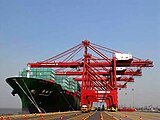| Revision as of 17:00, 2 January 2019 editFowler&fowler (talk | contribs)Autopatrolled, Extended confirmed users, File movers, Pending changes reviewers, Rollbackers63,232 edits →Text: Spelling/grammar correction Copyedit (minor)← Previous edit | Revision as of 17:20, 2 January 2019 edit undo2600:1001:b100:6459:cd2e:5ed4:363d:6690 (talk) →Text: replyNext edit → | ||
| Line 499: | Line 499: | ||
| ::::: The relevant paragraph from the history section: "After the 10th century, Muslim Central Asian nomadic clans, using swift-horse cavalry and raising vast armies united by ethnicity and religion, repeatedly overran South Asia's north-western plains, leading eventually to the establishment of the Islamic Delhi Sultanate in 1206. The sultanate was to control much of North India and to make many forays into South India. Although at first disruptive for the Indian elites, the sultanate largely left its vast non-Muslim subject population to its own laws and customs. By repeatedly repulsing Mongol raiders in the 13th century, the sultanate saved India from the devastation visited on West and Central Asia, setting the scene for centuries of migration of fleeing soldiers, learned men, mystics, traders, artists, and artisans from that region into the subcontinent, thereby creating a syncretic Indo-Islamic culture in the north. The sultanate's raiding and weakening of the regional kingdoms of South India paved the way for the indigenous Vijayanagara Empire. Embracing a strong Shaivite tradition and building upon the military technology of the sultanate, the empire came to control much of peninsular India, and was to influence South Indian society for long afterwards." ]] 16:05, 2 January 2019 (UTC) | ::::: The relevant paragraph from the history section: "After the 10th century, Muslim Central Asian nomadic clans, using swift-horse cavalry and raising vast armies united by ethnicity and religion, repeatedly overran South Asia's north-western plains, leading eventually to the establishment of the Islamic Delhi Sultanate in 1206. The sultanate was to control much of North India and to make many forays into South India. Although at first disruptive for the Indian elites, the sultanate largely left its vast non-Muslim subject population to its own laws and customs. By repeatedly repulsing Mongol raiders in the 13th century, the sultanate saved India from the devastation visited on West and Central Asia, setting the scene for centuries of migration of fleeing soldiers, learned men, mystics, traders, artists, and artisans from that region into the subcontinent, thereby creating a syncretic Indo-Islamic culture in the north. The sultanate's raiding and weakening of the regional kingdoms of South India paved the way for the indigenous Vijayanagara Empire. Embracing a strong Shaivite tradition and building upon the military technology of the sultanate, the empire came to control much of peninsular India, and was to influence South Indian society for long afterwards." ]] 16:05, 2 January 2019 (UTC) | ||
| {{User|Fowler&fowler}} by that logic, how was Christianity or Judaism significant to the history of the subcontinent? I don’t think British considered themselves as Christian power, as they divided Indian history in Hindu, Muslim and British. Why put Judaism here? Isn’t that exaggerating Jewish history in India? If you are impartial, shouldn’t Christianity and Judaism which take a sentence be removed? We can add Sikhs in the same sentence after Mughals. (] (]) 17:19, 2 January 2019 (UTC)) | |||
Revision as of 17:20, 2 January 2019
| This is the talk page for discussing improvements to the India article. This is not a forum for general discussion of the article's subject. |
|
| Find sources: Google (books · news · scholar · free images · WP refs) · FENS · JSTOR · TWL |
| Archives: Index, 1, 2, 3, 4, 5, 6, 7, 8, 9, 10, 11, 12, 13, 14, 15, 16, 17, 18, 19, 20, 21, 22, 23, 24, 25, 26, 27, 28, 29, 30, 31, 32, 33, 34, 35, 36, 37, 38, 39, 40, 41, 42, 43, 44, 45, 46, 47, 48, 49, 50, 51, 52, 53, 54, 55, 56, 57, 58, 59, 60Auto-archiving period: 30 days |
|
| This article is written in Indian English, which has its own spelling conventions (colour, travelled, centre, analysed, defence) and some terms that are used in it may be different or absent from other varieties of English. According to the relevant style guide, this should not be changed without broad consensus. |
 | India is a featured article; it (or a previous version of it) has been identified as one of the best articles produced by the Misplaced Pages community. Even so, if you can update or improve it, please do so. | ||||||||||||||||||||||||
| [REDACTED] | This article appeared on Misplaced Pages's Main Page as Today's featured article on December 3, 2004. | ||||||||||||||||||||||||
| |||||||||||||||||||||||||
| This article has not yet been rated on Misplaced Pages's content assessment scale. It is of interest to multiple WikiProjects. | |||||||||||||||||||||||||||||||||||||||||||||||||||||||
Please add the quality rating to the {{WikiProject banner shell}} template instead of this project banner. See WP:PIQA for details.
{{WikiProject banner shell}} template instead of this project banner. See WP:PIQA for details.
{{WikiProject banner shell}} template instead of this project banner. See WP:PIQA for details.
{{WikiProject banner shell}} template instead of this project banner. See WP:PIQA for details.
| |||||||||||||||||||||||||||||||||||||||||||||||||||||||
This article has been mentioned by multiple media organizations:
|
| The contentious topics procedure applies to this page. This page is related to India, Pakistan, and Afghanistan, which has been designated as a contentious topic. Editors who repeatedly or seriously fail to adhere to the purpose of Misplaced Pages, any expected standards of behaviour, or any normal editorial process may be blocked or restricted by an administrator. Editors are advised to familiarise themselves with the contentious topics procedures before editing this page. |
Template:Outline of knowledge coverage
| This is the talk page for discussing improvements to the India article. This is not a forum for general discussion of the article's subject. |
|
| Find sources: Google (books · news · scholar · free images · WP refs) · FENS · JSTOR · TWL |
| Archives: Index, 1, 2, 3, 4, 5, 6, 7, 8, 9, 10, 11, 12, 13, 14, 15, 16, 17, 18, 19, 20, 21, 22, 23, 24, 25, 26, 27, 28, 29, 30, 31, 32, 33, 34, 35, 36, 37, 38, 39, 40, 41, 42, 43, 44, 45, 46, 47, 48, 49, 50, 51, 52, 53, 54, 55, 56, 57, 58, 59, 60Auto-archiving period: 30 days |
Updation of images in Economy section
The images in the Economy section are too agricultural specific, despite the fact that agriculture now contributes only about 20% of India's GDP. Here are all the images currently in this section:
Image Section 1-
 A1 A farmer in Rajasthan milks his cow. Milk is India's largest crop by economic value. Worldwide, as of 2011, India had the largest herds of buffalo and cattle, and was the largest producer of milk.
A1 A farmer in Rajasthan milks his cow. Milk is India's largest crop by economic value. Worldwide, as of 2011, India had the largest herds of buffalo and cattle, and was the largest producer of milk.
-
 A2 Agricultural workers involved in Rice planting. Rice production in India reached 102.75 million tons in 2011–12.
A2 Agricultural workers involved in Rice planting. Rice production in India reached 102.75 million tons in 2011–12.
-
 A3Indian agriculture dates from the period 7,000–6,000 BCE, employs most of the national workforce, and is second in farm output worldwide. Above, a farmer works an ox-drawn plow in Kadmati, West Bengal.
A3Indian agriculture dates from the period 7,000–6,000 BCE, employs most of the national workforce, and is second in farm output worldwide. Above, a farmer works an ox-drawn plow in Kadmati, West Bengal.
-
 A4 Fishermen on the Chinese fishing nets of Cochin. Fisheries in India is a major industry in its coastal states, employing over 14 million people. The annual catch doubled between 1990 and 2010.
A4 Fishermen on the Chinese fishing nets of Cochin. Fisheries in India is a major industry in its coastal states, employing over 14 million people. The annual catch doubled between 1990 and 2010.
-
 A5 A washing plant for mined iron ore in Orissa. India's iron ore reserves of 25 billion tonnes comprise 6% of global reserves. India is the world's 4th largest producer and 3rd largest exporter.
A5 A washing plant for mined iron ore in Orissa. India's iron ore reserves of 25 billion tonnes comprise 6% of global reserves. India is the world's 4th largest producer and 3rd largest exporter.
-
A6 India's GDP has increased more than ten-fold after the economic reforms in 1991.
-
 A7 A daily wage worker in a salt field. The average minimum wage of daily labourers is around Rs.100 per day
A7 A daily wage worker in a salt field. The average minimum wage of daily labourers is around Rs.100 per day
-
 A8 Schoolchildren in Chambal, Madhya Pradesh eating a mid-day meal. The Mid-Day Meal Scheme attempts to lower rates of childhood malnutrition in India.
A8 Schoolchildren in Chambal, Madhya Pradesh eating a mid-day meal. The Mid-Day Meal Scheme attempts to lower rates of childhood malnutrition in India.
- Out of 8 images in this section, 5 (A1, A2, A3, A4 and A7) are related to agriculture / diary / fisheries.
- A8 is of a mid-day deal meal program. This image is a complete mis-fit for this section.
- As evident, the data in caption of most of these images is highly outdated -- from way back in 2010-11.
-
 P1 Agricultural workers in Tamilnadu involved in rice planting
P1 Agricultural workers in Tamilnadu involved in rice planting
- If the near domination of agriculture in Section 1 wasn't enough, we have another image on paddy cultivation.
-
 B1 The Bombay Stock Exchange is Asia's oldest and India's largest bourse by market capitalisation.
B1 The Bombay Stock Exchange is Asia's oldest and India's largest bourse by market capitalisation.
-
 B2 Tidel Park, the then largest IT park in Asia when it was opened in 2000.
B2 Tidel Park, the then largest IT park in Asia when it was opened in 2000.
-
 B3 The Delhi Metro rapid transit system and the low-floor CNG buses. Infrastructure in India in the next five years is estimated to bring in $1 trillion in investment, half of it by India's private sector.
B3 The Delhi Metro rapid transit system and the low-floor CNG buses. Infrastructure in India in the next five years is estimated to bring in $1 trillion in investment, half of it by India's private sector.
-
 B4 India has the world's second-largest mobile phone user base of 996.66 million users as of September 2015. Shown here is a rooftop mobile phone tower in Bangalore
B4 India has the world's second-largest mobile phone user base of 996.66 million users as of September 2015. Shown here is a rooftop mobile phone tower in Bangalore
-
 B5 A vegetable retailer in Tamil Nadu. More than 95% of retail industry in India is unorganised.
B5 A vegetable retailer in Tamil Nadu. More than 95% of retail industry in India is unorganised.
-
 B6 New under-construction units of Kakrapar Atomic Power Stationin Gujarat. The electricity sector in India has an installed capacity of 346.05 Gigawatt (GW), the world's third largest. Coal-fired plants account for 56% of India's electricity capacity.
B6 New under-construction units of Kakrapar Atomic Power Stationin Gujarat. The electricity sector in India has an installed capacity of 346.05 Gigawatt (GW), the world's third largest. Coal-fired plants account for 56% of India's electricity capacity.
-
 B8 A container ship at Jawaharlal Nehru Port, Mumbai. International trade accounted for 14% of India's GDP in 1988, 24% in 1998, and 53% in 2008.
B8 A container ship at Jawaharlal Nehru Port, Mumbai. International trade accounted for 14% of India's GDP in 1988, 24% in 1998, and 53% in 2008.
- B5 Another image representing agricultural sector
- B4 This is just a mobile tower. How is this image adding any value?
- B3 The image is so crowded. The subjects of the caption (CNG buses and Metro) are not in focus. Very bad image.
I hope that the veteran Wikipedians would understand the point I am wanting to make here. The images badly need an upgrade to accurately depict the rapid industralization of Indian economy, especially in the past 10 years. --King Zebu (talk) 07:04, 2 December 2018 (UTC)
New Images - Proposal #1
Proposed by King Zebu-
 N1: Replacement for B3 The subject is the focus of the image
N1: Replacement for B3 The subject is the focus of the image
-
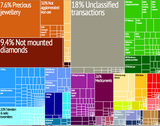 N2 Export treemap - Highly relevant to the section. Propose to make this a permanent fixture rather than have it on rotation. So, replacement for P1
N2 Export treemap - Highly relevant to the section. Propose to make this a permanent fixture rather than have it on rotation. So, replacement for P1
-
N3 Propose as replacement for A1. A high quality image which showcases industralization of diary processing sector in India.
-
 N4 Propose as replacement for B4. Much more relevant and informative, as compared to just showing a mobile tower. Showcases India's rapidly growing education and training sector which in turn supports India's massive information technology and business process management sector.
N4 Propose as replacement for B4. Much more relevant and informative, as compared to just showing a mobile tower. Showcases India's rapidly growing education and training sector which in turn supports India's massive information technology and business process management sector.
-
 N5 Propose as replacement for B5. India's organised retail sector deserves to represented because it is growing by 20-25% annually and will reach 18-20% of the total sector by 2020.
N5 Propose as replacement for B5. India's organised retail sector deserves to represented because it is growing by 20-25% annually and will reach 18-20% of the total sector by 2020.
-
 N6 Propose as replacement for A3 There are no images representing India's industrial sector and the agricultural sector is over-represented.
N6 Propose as replacement for A3 There are no images representing India's industrial sector and the agricultural sector is over-represented.
-
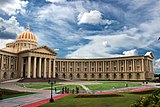 N7 replacement for B2 Infosys Leadership Institute in Bangalore. Apart from representing one of India's premier IT companies, this image also highlights Bangalore, the IT hub of India and one of its largest cities.
N7 replacement for B2 Infosys Leadership Institute in Bangalore. Apart from representing one of India's premier IT companies, this image also highlights Bangalore, the IT hub of India and one of its largest cities.
-
 N8 replacement for A5 There is no image representing science and technology in India and no mention of India's growing role in space launch industry. Besides, A5 is a poor quality and again, the subject is not in focus but is rather in the background.
N8 replacement for A5 There is no image representing science and technology in India and no mention of India's growing role in space launch industry. Besides, A5 is a poor quality and again, the subject is not in focus but is rather in the background.
--King Zebu (talk) 07:46, 2 December 2018 (UTC)
- I support these image replacement proposals, but N2 doesn't look high quality too me.--ThaThinThaKiThaTha (talk) 09:48, 2 December 2018 (UTC)
- Hi, thanks for your positive response. Regarding N2, it's a graphical representation of India's exports. Several articles (such as, Canada) use these treemaps for graphical representation of a country's exports. But that said, I agree with your viewpoint that the image is not of high quality since some of the text is not readable. --King Zebu (talk) 10:15, 2 December 2018 (UTC)
- N1 for B3: Yes. N2 for P1: No. N2 is not really an image and we should use images. I agree that P1 needs replacing though. N3 for A1: No. The dairy plant is too generic where BSE is an important building. N4 for B4: Yes (nice picture!). N5 for B5: No. Again, a mall is too generic. Plus, the street vendor market is actually more representative of India than the mall. N6 for A3: No. I'm not averse to replacing the picture but we should look for something more significant. An important factory for instance. N7 for B2: Yes. N8 for A5: Yes (another nice picture). Nice work King Zebu. The pictures definitely need updating so this is very useful. --regentspark (comment) 14:24, 2 December 2018 (UTC)
- Thank you Regent for your kind words :-) Regarding N3, I wanted to replace it with A1 (and not B1) which showcases a dairy farmer milking a cow. I personally don't like A1 at all because it simply doesn't add much value. It's fine if you don't want N3, but in my humble opinion, A1 should be removed. And yes, B1 represents the BSE in Mumbai (India's financial capital) - so it definitely deserves a place in this article. --King Zebu (talk) 17:43, 2 December 2018 (UTC)
- A1 by N3 is ok (the text could say something about the modern dairy plants and the increase in milk production over the last 50 years). --regentspark (comment) 17:49, 2 December 2018 (UTC)
- Thank you Regent for your kind words :-) Regarding N3, I wanted to replace it with A1 (and not B1) which showcases a dairy farmer milking a cow. I personally don't like A1 at all because it simply doesn't add much value. It's fine if you don't want N3, but in my humble opinion, A1 should be removed. And yes, B1 represents the BSE in Mumbai (India's financial capital) - so it definitely deserves a place in this article. --King Zebu (talk) 17:43, 2 December 2018 (UTC)
It has been a week since I proposed these changes and looks like we a consensus here. So, I'll be BOLD and implement the changes. Thanks :-) --King Zebu (talk) 04:38, 9 December 2018 (UTC)
New Images - Proposal #2
Proposed 2 by King Zebu--King Zebu (talk) 10:31, 2 December 2018 (UTC)
- I think both the original B8 and the one you replaced it by can be replaced. But none of these are any better. N11 might work though so, if nothing better can be found, I'd go with that. --regentspark (comment) 17:27, 2 December 2018 (UTC)
Semi-protected edit request on 14 December 2018
This edit request has been answered. Set the |answered= or |ans= parameter to no to reactivate your request. |
Akhileshyadav287 (talk) 06:56, 14 December 2018 (UTC)
 Not done: it's not clear what changes you want to be made. Please mention the specific changes in a "change X to Y" format and provide a reliable source if appropriate. DannyS712 (talk) 07:25, 14 December 2018 (UTC)
Not done: it's not clear what changes you want to be made. Please mention the specific changes in a "change X to Y" format and provide a reliable source if appropriate. DannyS712 (talk) 07:25, 14 December 2018 (UTC)
Numbering system
Following on from this and subsequent edits, the discussion below has been copied from User_talk:Azuredivay#Your_edits_to_India to encourage wider consensus following temporary protection from editing.
Please read Misplaced Pages:Manual_of_Style#Opportunities for commonality. It will be better if you get yourself familiarized with Misplaced Pages guidelines. Also, what part of "discuss this further in talkpage" did you not understand? You should wait for my response atleast before engaging in revert war. --King Zebu (talk) 05:32, 16 December 2018 (UTC)
I did, wiki guidelines do mention context, and in the context of the topic of the article, the numbering does make sense, and I add links to alternate numbering. As for reverts, I did as you did, I wouldn't want people to be devoid of information due to your delay in deciding what you think if the right way to write.
- Wiki guidelines at MOS:NUMERAL also mention "Group digits in Western thousands-based style (e.g., 30,000,000; not 3,00,00,000)", which you have ignored again. Please read the manual of style properly before editing further, especially the item stating "Sometimes, the variety of English used in an article may suggest the use of a numbering system other than the Western thousands-based system. For example, the South Asian numbering system is conventionally used for certain things (especially monetary amounts) in South Asian English. This is discouraged in Misplaced Pages articles by Misplaced Pages:Manual_of_Style#Opportunities_for_commonality." Bazza (talk) 10:57, 18 December 2018 (UTC)
Discouraged, not disallowed.
- Indeed. And Misplaced Pages:Manual_of_Style#Opportunities_for_commonality goes on to say "Use universally accepted terms rather than those less widely distributed, especially in titles. For example, glasses is preferred to the national varieties spectacles (British English) and eyeglasses (American English); ten million is preferable to one crore (Indian English)." It also adds "When an English variety's consistent usage has been established in an article, maintain it in the absence of consensus to the contrary.", which is not what you have been doing. Also, "With few exceptions (e.g., when a topic has strong national ties or a term/spelling carries less ambiguity), there is no valid reason for such a change.": the South Asian numbering system is not less ambiguous or clear to the majority of English Misplaced Pages readers, many of whom may not have English as their first language, nor any familiarity with the numbering system concerned.
It is good to see that you have refrained from further disruption.Bazza (talk) 13:26, 18 December 2018 (UTC)- It looks like I've assumed good faith which you have not earned, and you are still disruptively editing. I've struck out my previous comment. Bazza (talk) 13:36, 18 December 2018 (UTC)
Please do not name it 'disruption' when it isn't withholding information. I'm stating both numbering systems with links to both, seeing how it's an article on India, I'll stick to it being written in both Indian numbering system and the other one.
- But you are not doing that. You have repeatedly used two-digit groupings for large numbers (such as population); you redid your change which was reverted with a request (from User:King Zebu) to discuss first which you ignored. You have also ignored the instructions "When an English variety's consistent usage has been established in an article, maintain it in the absence of consensus to the contrary." which I referred to above. That is disruption. Bazza (talk) 15:02, 18 December 2018 (UTC)
And you say this while you're ignoring that if those were the violating edits, why were all of my crore (million) edits were removed too. That said, I could do the same with comma separated numbers with INS(Other NS) if that helps my edit be more in line with Misplaced Pages standards
- Pressing "undo" reverts everything in an edit. It's more likely to happen if you make many changes in the same edit; do not provide any useful information in the edit summary; and do not engage in discussion when asked. Having large numeric values specified twice in two different formats is not acceptable: you should use three-digit separation only as specified at MOS:NUMERAL. Your primary use of uncommon number names (such as crore and lakh) ignores Misplaced Pages:Manual_of_Style#Opportunities_for_commonality. And you are making all these changes in defiance of "When an English variety's consistent usage has been established in an article, maintain it in the absence of consensus to the contrary." I do not understand why you persevere in this behaviour. If you do not like the MOS standards then petition to get them changed to suit your preferences rather than persistently edit disruptively. Bazza (talk) 15:36, 18 December 2018 (UTC)
I did provide that information previously, until all of them were ignored. That said, I intend to keep it in Indian numbering system seeing how the article is indeed written in "Indian English" which sees those words as dictionary words.
End of copy Bazza (talk) 10:46, 20 December 2018 (UTC)
Restoring last good version
I suggested to the protecting admin, CambridgeBayWeather, that reverting the disruptive addition was important, especially since there is erroneous information, some of which is in the lead. No action was promised or has been forthcoming. Is it worth trying to get someone to revert before Wednesday, December 26? Dhtwiki (talk) 03:14, 21 December 2018 (UTC)
- What are we referring to when we say "erroneous" information? — Preceding unsigned comment added by Azuredivay (talk • contribs) 07:34, 21 December 2018 (UTC)
- I put the errors in my post on CambridgeBayWeather's user talk page. IIRC, the lead says that India has a population of 1,200 crore, which equals 12 billion. There's also one other erroneous conversion, farther down, in a section on geological origins, where 7.5 lakh equals 75 million, where obviously crore is meant. Not huge errors, but, esp. the first, apt to puzzle some people and make them wonder at why the article is a featured one. Add to that all the odd usage of digit separators, which is practically unique on WP, although in line with Indian usage. Dhtwiki (talk) 00:41, 22 December 2018 (UTC)
- All you need for a change is a few people agreeing to it on this talk page. Then use {{edit protected}} — Martin (MSGJ · talk) 09:05, 21 December 2018 (UTC)
- This protection is a good example of disruptive mindless administration. I don't know why people feel the need to administer something without doing any proper analysis of the problem.--ThaThinThaKiThaTha (talk) 09:32, 21 December 2018 (UTC)
- The article's improvement was going nowhere. Protecting it for a short period has given a breathing space for calming down, and time for the discussion to be moved from the disruptive editor's talk page to the article's talk page so more people can participate, which seems to have worked. Bazza (talk) 10:00, 21 December 2018 (UTC)
- I don't see any discussion regarding content. This discussion is about the protection policy, not about the content.--ThaThinThaKiThaTha (talk) 10:32, 21 December 2018 (UTC)
- This discussion falls under the heading "Numbering system", the first part of which arose from disruptive content changes. This subsection is about the protection which was applied as a result of those changes. You commented that the protection was applied without due thought to the problem at hand. I disagreed with that because I think the protection has served its purpose, frustrating though it is to the editors involved, including me. I never mentioned "content", only the protection process which has been gone through in this instance. If you are making general comments about protection policies, there are probably better places to get a more productive discussion than on the India article's talk page. Bazza (talk) 10:48, 21 December 2018 (UTC)
- I don't see any discussion regarding content. This discussion is about the protection policy, not about the content.--ThaThinThaKiThaTha (talk) 10:32, 21 December 2018 (UTC)
- The article's improvement was going nowhere. Protecting it for a short period has given a breathing space for calming down, and time for the discussion to be moved from the disruptive editor's talk page to the article's talk page so more people can participate, which seems to have worked. Bazza (talk) 10:00, 21 December 2018 (UTC)
I hope we stick to the current edit with Indian numbering system in parallel to the more common one used throughout wiki, as the words are part of Indian English that the page is written in, and add more information without withholding anything or giving any wrong information - Azuredivay — Preceding unsigned comment added by Azuredivay (talk • contribs) 20:42, 21 December 2018 (UTC)
- This article is not to be confused with Indian English, where your content may have a valid place. This article is not about Indian English, but about India, the country. I don't see any evidence of that this article has been written in Indian English?! --ThaThinThaKiThaTha (talk) 22:40, 21 December 2018 (UTC)
Read the top, the article IS in Indian English, with local numbering making more sense to local readers, for other readers the other numbering is provided as well. This serves more people as more understand the context and gravity of what is being talked about. - Azuredivay — Preceding unsigned comment added by Azuredivay (talk • contribs) 13:43, 22 December 2018 (UTC)
- Mr. Azure, firstly please sign your comments on talkpages. Secondly, I urge you to look at the other side of the coin. While you do have a point in promoting Indian numbering system, especially on India-related articles - your strategy of including both Indian and Western numbering system is flawed. Including both numeral systems unnecessarily lengthens the text and creates more confusion. It doesn't add ANY value to the article and besides, vast majority of English-speaking Indians are anyways aware of Western numbering system (millions & billions vs. lakhs & crores). This the main India article and needs to be to-the-point. Tomorrow, someone will start pushing Hinglish in an attempt to "make sense to local readers". Please provide evidence to backup your claim that English-speaking Indians cannot make sense of millions and billions. Lastly, Misplaced Pages policy clearly discourages usage of inconsistent terminologies and since the vast consensus here is against your proposed changes, maybe you should take a rest. --King Zebu (talk) 08:22, 23 December 2018 (UTC)
- I thought there was a policy or guideline that explicitly mentioned idiosyncratic Indian numerical expressions as exceptions to adhering to Indian English in an article but could not find such. If there is one, perhaps it could be pointed out. Dhtwiki (talk) 23:31, 23 December 2018 (UTC)
- MOS:NUMERAL states "Sometimes, the variety of English used in an article may suggest the use of a numbering system other than the Western thousands-based system. For example, the South Asian numbering system is conventionally used for certain things (especially monetary amounts) in South Asian English. This is discouraged in Misplaced Pages articles by WP:Manual of Style § Opportunities for commonality.", and provides some more instructions including "Group digits in Western thousands-based style (e.g., 30,000,000; not 3,00,00,000)". Bazza (talk) 11:27, 24 December 2018 (UTC)
- That must be it. Thank you. Dhtwiki (talk) 23:46, 24 December 2018 (UTC)
- MOS:NUMERAL states "Sometimes, the variety of English used in an article may suggest the use of a numbering system other than the Western thousands-based system. For example, the South Asian numbering system is conventionally used for certain things (especially monetary amounts) in South Asian English. This is discouraged in Misplaced Pages articles by WP:Manual of Style § Opportunities for commonality.", and provides some more instructions including "Group digits in Western thousands-based style (e.g., 30,000,000; not 3,00,00,000)". Bazza (talk) 11:27, 24 December 2018 (UTC)
Having being educated in India for the most part, I know western numbering is a part of CBSE's curriculum which is followed by most Indian schools, it Is not the numbering we use in Maths/English, anything beyond knowing that "this is what western numbering is and this is how you can convert". My sole reason for this change is the fact that me, like most other Indian readers, spend a big chunk of our time converting millions to lakhs/crores as the former does not accurately show the "gravity" of the number in question. That said, my intention of having both numbering system does NOT increase the article length to the point where it is disruptive to read. And it does help more readers understand what is being talked about. - Azuredivay — Preceding unsigned comment added by Azuredivay (talk • contribs) 16:21, 26 December 2018 (UTC)
- What is disruptive is that your conversions were wrong in at least two instances and there have been two or three posts here, outside those of the regular group, trying to correct one of them. Never mind your obstinacy in thinking the article should be the way you want it, in spite of those who should have alerted you to the fact that your point of view is an unusual one and never mind the full protection of one of the most frequently accessed articles on Misplaced Pages, which I think may be unique in my experience. Dhtwiki (talk) 23:01, 26 December 2018 (UTC)
Protected edit request on 21 December 2018
This edit request has been answered. Set the |answered= or |ans= parameter to no to reactivate your request. |
The Largest city of India is Delhi 115.96.198.195 (talk) 07:53, 21 December 2018 (UTC)
 Not done: it's not clear what changes you want to be made. Please mention the specific changes in a "change X to Y" format and provide a reliable source if appropriate. — Martin (MSGJ · talk) 09:03, 21 December 2018 (UTC)
Not done: it's not clear what changes you want to be made. Please mention the specific changes in a "change X to Y" format and provide a reliable source if appropriate. — Martin (MSGJ · talk) 09:03, 21 December 2018 (UTC)
Population
There's a mathematical problem in the infobox. It should say (for 2016) 1,324,171,354. The same for 2011.--יניב הורון (Yaniv) (talk) 20:28, 22 December 2018 (UTC)
- Hey, completely understand your confusion. Unfortunately, an Admin thought it was best to reward someone who engaged in edit-warring, POV-pushing and violated Misplaced Pages MOS guidelines --King Zebu (talk) 08:46, 23 December 2018 (UTC)
Hey team wikipedia,kindly correct the population of india written in very starting of the article.Actually india's population is around 121crore(census 2011),but in this article it is mentioned that india's population is 1200 crore insted of 121 or 120 crore.So kindly correct it. Ankit Singh dhannu (talk) 15:30, 25 December 2018 (UTC)
- We've noticed that population figure is wrong, but the article is under full protection, due to edit warring, which has prevented most of us from correcting it until tomorrow (hopefully). However, thank you for mentioning this, as it justifies the urgency in correcting it that some of us have felt and that we feel others should have shared. Dhtwiki (talk) 22:46, 25 December 2018 (UTC)
Protected edit request on 23 December 2018
This edit request has been answered. Set the |answered= or |ans= parameter to no to reactivate your request. |
So, User:Azuredivay started pushing his agenda / POV in violation MOS:COMMONALITY and MOS:NUMERAL, repeatedly ignored pleas to engage in a discussion and build consensus and then engaged in multiple revert wars( .
And what do the Admins do? They protect the article keeping the version which User:Azuredivay wanted - basically rewarding him for his edit warring, for not building consensus and for not following Misplaced Pages:Manual of Style guidelines. Wow! Do the Admins even read Misplaced Pages:Policies and guidelines anymore? --King Zebu (talk) 08:33, 23 December 2018 (UTC) King Zebu (talk) 08:33, 23 December 2018 (UTC)
- I looked at the first diff above and you are correct, that diff is pretty shocking and anything like it should be removed. However, much of the rest of the above is not going to help. Admins are not permitted to adjudicate disputes, but they are encouraged to stop edit wars. The way to approach someone on a mission is slowly. Someone else should notice a problem and revert. Ask for assistance at noticeboards. If one person is reverting a bunch of people the one person can be reported at WP:EWN. All that can be done now is to discuss the issue calmly. Johnuniq (talk) 08:48, 23 December 2018 (UTC)
- Done --King Zebu (talk) 09:33, 23 December 2018 (UTC)
- Sorry but reporting a user now, after an admin has chosen to protect the article, may not get a result you want. Also, comments have to be very polite: stick to "against consensus, against MOS" and do not mention stuff like "pushing his agenda" or "POV". That makes it look like a battle between opposing forces for which the remedy is to block everyone (or protect the article). What needs to happen to the article at the moment? Does it need to be reverted to an earlier version? Please link to that version so others can comment on whether that would be desirable. Johnuniq (talk) 09:43, 23 December 2018 (UTC)
- Done --King Zebu (talk) 09:33, 23 December 2018 (UTC)
- Declined as edit request doesnt actually include a request to change the article. Edit request should indicate the changes required and supporting references and discussion. MilborneOne (talk) 09:56, 23 December 2018 (UTC)
- Done - raised another request. --King Zebu (talk) 10:05, 23 December 2018 (UTC)
Protected edit request on 23 December 2018
This edit request has been answered. Set the |answered= or |ans= parameter to no to reactivate your request. |
Please revert changes made by User:Azuredivay which I believe are not in sync with MOS:COMMONALITY and MOS:NUMERAL and these changes were made without building consensus on talkpage despite repeatedly pleas to do so. --King Zebu (talk) 10:04, 23 December 2018 (UTC)
Changes provide more info and help more people understand the figures being talked about as the said numbers are common for the target readers. That said, for rest the other numbering system is written in parallel so no information is withheld. -Azuredivay — Preceding unsigned comment added by Azuredivay (talk • contribs) 14:03, 23 December 2018 (UTC)
- I've already replied back to your flawed logic here. You have a history of deviant behaviour and edit warring on Misplaced Pages and show little regard for building consensus, even telling one User "I dare you to stop me". --King Zebu (talk) 15:06, 23 December 2018 (UTC)
 Not done this content dispute will need to be worked out here on the talk page first; this does not appear to be a pressing factual correction that will harm readers. — xaosflux 18:05, 23 December 2018 (UTC)
Not done this content dispute will need to be worked out here on the talk page first; this does not appear to be a pressing factual correction that will harm readers. — xaosflux 18:05, 23 December 2018 (UTC)
Coordinate error
{{geodata-check}}
The following coordinate fixes are needed for 49.14.101.189 (talk) 06:01, 25 December 2018 (UTC)
- Needs a bit for information on what you think is wrong. MilborneOne (talk) 09:25, 25 December 2018 (UTC)
Protected edit request on 26 December 2018
This edit request has been answered. Set the |answered= or |ans= parameter to no to reactivate your request. |
Total population is not rightly quoted. 122.162.29.109 (talk) 05:30, 26 December 2018 (UTC)
 Not done: it's not clear what changes you want to be made. Please mention the specific changes in a "change X to Y" format and provide a reliable source if appropriate. General Ization 05:32, 26 December 2018 (UTC)
Not done: it's not clear what changes you want to be made. Please mention the specific changes in a "change X to Y" format and provide a reliable source if appropriate. General Ization 05:32, 26 December 2018 (UTC)
Unofficial version of national anthem with incorrect timings
Why is an unofficial version of national anthem with incorrect timing is used in Misplaced Pages? 1337 siddh (talk) 14:34, 28 December 2018 (UTC)
Large scale edits to India Comment
I have reverted large scale edits to this article to the last stable version edited by @RegentsPark:. To the editors engaging in these edits, please note: India is a featured article. Please read WP:OWN#Featured_articles for guidelines on how to edit an FA. For adding anything significant, sometimes even one sentence, you need to gain consensus on the talk page first, especially when an edit has been challenged. Best regards, Fowler&fowler«Talk» 21:19, 1 January 2019 (UTC)
- @Highpeaks: has undone your reverts fowler. Highpeaks, I'm going to revert you. The edits largely contain many new images and the consensus for images on this article are that they should only be changed by consensus. Some of the changes do have consensus and I'm pinging @King Zebu:, with apologies, so that those changes can be restored. Highpeaks, please look at the discussion on the top of this talk page to see how to go about proposing changes to the images in this article. --regentspark (comment) 22:01, 1 January 2019 (UTC)
- @Highpeaks35:. (Fixing bad ping above.)--regentspark (comment) 22:02, 1 January 2019 (UTC)
- @RegentsPark: this version has tons of old data and there are tons of updated references and info. It will be best to restore and remove areas that are not agreeded upon. This is too much revision to have any discussion. Let me know what you think. (Highpeaks35 (talk) 22:10, 1 January 2019 (UTC))
- I will leave the changes here. If anyone has objections, please advise. If not, I will restore the updated data, images, and content. (Highpeaks35 (talk) 22:14, 1 January 2019 (UTC))
- (ec) Could you give examples of the old data? I think 2019 gdp estimates are premature so 2018 is probably better. Are there other examples?--regentspark (comment) 22:15, 1 January 2019 (UTC)
- Data was one of the several points. But, it seems population data is also reversed and others. As mentioned, there are tons of updated info and references. Again, if there is no objection, I don’t see what is the issue of restoring. I was under the assumption of Misplaced Pages:There is no deadline, plus it is not a protected article. Again, if there is objection, the content will be changed, if not, we should restore. (Highpeaks35 (talk) 22:23, 1 January 2019 (UTC))
- You can't restore the image changes because those need consensus. If you think some data is incorrect, go ahead and change those. --regentspark (comment) 23:48, 1 January 2019 (UTC)
- @RegentsPark: thank you so much! Will do. :) (Highpeaks35 (talk) 00:20, 2 January 2019 (UTC))
- You can't restore the image changes because those need consensus. If you think some data is incorrect, go ahead and change those. --regentspark (comment) 23:48, 1 January 2019 (UTC)
- Data was one of the several points. But, it seems population data is also reversed and others. As mentioned, there are tons of updated info and references. Again, if there is no objection, I don’t see what is the issue of restoring. I was under the assumption of Misplaced Pages:There is no deadline, plus it is not a protected article. Again, if there is objection, the content will be changed, if not, we should restore. (Highpeaks35 (talk) 22:23, 1 January 2019 (UTC))
- (ec) Could you give examples of the old data? I think 2019 gdp estimates are premature so 2018 is probably better. Are there other examples?--regentspark (comment) 22:15, 1 January 2019 (UTC)
- I will leave the changes here. If anyone has objections, please advise. If not, I will restore the updated data, images, and content. (Highpeaks35 (talk) 22:14, 1 January 2019 (UTC))
- @RegentsPark: this version has tons of old data and there are tons of updated references and info. It will be best to restore and remove areas that are not agreeded upon. This is too much revision to have any discussion. Let me know what you think. (Highpeaks35 (talk) 22:10, 1 January 2019 (UTC))
- @Highpeaks35:. (Fixing bad ping above.)--regentspark (comment) 22:02, 1 January 2019 (UTC)
@Highpeaks35: You're still adding images without consensus and you can't do that without appearing disruptive. I'm going to revert your edits again, let the discussion below run its course first. --regentspark (comment) 02:38, 2 January 2019 (UTC)
- Which image? I thought I removed all of them? (Highpeaks35 (talk) 02:43, 2 January 2019 (UTC))
New Images - Proposals
Please let me know if there are any objections to these new rotating images. Kindly comment below. (Highpeaks35 (talk) 00:31, 2 January 2019 (UTC))
New Images - Clothing
- Rotate

- Images
-
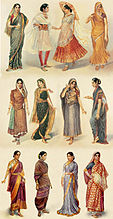 Illustration of different styles of sari, gagra choli and shalwar kameez worn by women in India.
Illustration of different styles of sari, gagra choli and shalwar kameez worn by women in India.
-
 The Didarganj Yakshi depicting the dhoti wrap.
The Didarganj Yakshi depicting the dhoti wrap.
-
Achkan sherwani and churidar (lower body) worn by Arvind Singh Mewar and his kin during a Hindu wedding in Rajasthan, India.
-
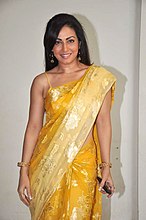 Indian actress Pakhi Hegde wearing a string-sleeve choli and sari.
Indian actress Pakhi Hegde wearing a string-sleeve choli and sari.
-
 Indian actress Shriya Saran in woman's kameez with dupatta draped over the neck and decorative bindi on the centre of her forehead.
Indian actress Shriya Saran in woman's kameez with dupatta draped over the neck and decorative bindi on the centre of her forehead.
-
 Indian actress Priyanka Chopra wearing a lehenga and gagra choli; and exposes the midriff and navel, which has long been a fashion with Indian women in popular culture.
Indian actress Priyanka Chopra wearing a lehenga and gagra choli; and exposes the midriff and navel, which has long been a fashion with Indian women in popular culture.
-
 Traditional Hajong Pathin and Argon from Northeast India.
Traditional Hajong Pathin and Argon from Northeast India.
-
 An Assamese girl wearing mekhela sador dress and bindi on the centre of her forehead.
An Assamese girl wearing mekhela sador dress and bindi on the centre of her forehead.
-
 A Hindu Indian wedding, with the groom wearing a sherwani and pagri turban, while the bride in a sari.
A Hindu Indian wedding, with the groom wearing a sherwani and pagri turban, while the bride in a sari.
Support or Oppose
- Support: The rotating image provides value to section. (Highpeaks35 (talk) 02:34, 2 January 2019 (UTC))
New Images - Cuisine
- Rotate

- Images
-
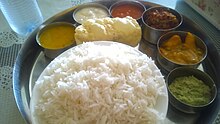 South Indian style vegetarian thali served in a restaurant.
South Indian style vegetarian thali served in a restaurant.
-
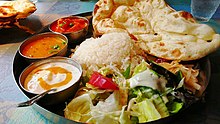 North Indian style vegetarian thali served in a restaurant.
North Indian style vegetarian thali served in a restaurant.
-
 Rajasthani style vegetarian thali served in a restaurant.
Rajasthani style vegetarian thali served in a restaurant.
-
 Gujarati style vegetarian thali served in a restaurant.
Gujarati style vegetarian thali served in a restaurant.
-
 Assamese style thali served in a restaurant.
Assamese style thali served in a restaurant.
-
 Andhra style vegetarian thali served in a restaurant.
Andhra style vegetarian thali served in a restaurant.
-
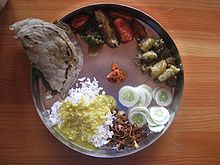 Karnataka style vegetarian thali served in a restaurant.
Karnataka style vegetarian thali served in a restaurant.
-
 Bengali style thali served in a restaurant.
Bengali style thali served in a restaurant.
-
 Sikkimese style thali served in a restaurant.
Sikkimese style thali served in a restaurant.
-
 Punjabi style vegetarian thali served in a restaurant.
Punjabi style vegetarian thali served in a restaurant.
Support or Oppose
- Support: The rotating image provides value to section. (Highpeaks35 (talk) 02:34, 2 January 2019 (UTC))
New Images - Literature
- Rotate

- Images
-
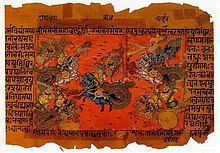 A manuscript illustration of the Battle of Kurukshetra, fought between the Kauravas and the Pandavas, recorded in the Mahābhārata.
A manuscript illustration of the Battle of Kurukshetra, fought between the Kauravas and the Pandavas, recorded in the Mahābhārata.
-
 The Battle at Lanka, Ramayana by Sahibdin. It depicts the monkey army of the protagonist Rama (top left, blue figure) fighting Ravana—the demon-king of the Lanka—to save Rama's kidnapped wife, Sita. The painting depicts multiple events in the battle against the three-headed demon general Trisiras, in the bottom left. Trisiras is beheaded by Hanuman, the monkey-companion of Rama.
The Battle at Lanka, Ramayana by Sahibdin. It depicts the monkey army of the protagonist Rama (top left, blue figure) fighting Ravana—the demon-king of the Lanka—to save Rama's kidnapped wife, Sita. The painting depicts multiple events in the battle against the three-headed demon general Trisiras, in the bottom left. Trisiras is beheaded by Hanuman, the monkey-companion of Rama.
-
 Rama and Hanuman fighting Ravana from Ramavataram, an album painting on paper from Tamil Nadu, c. 1820 CE.
Rama and Hanuman fighting Ravana from Ramavataram, an album painting on paper from Tamil Nadu, c. 1820 CE.
-
 Ilango Adigal is the author of Silappatikaram, one of the five great epics of Tamil literature.
Ilango Adigal is the author of Silappatikaram, one of the five great epics of Tamil literature.
Support or Oppose
- Support: The rotating image provides value to section. (Highpeaks35 (talk) 02:34, 2 January 2019 (UTC))
New Images - Architecture
- Rotate

- Images
-
 Ashoka pillar at Vaishali, 250 BCE.
Ashoka pillar at Vaishali, 250 BCE.
-
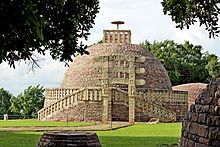 Sanchi Stupa No.2, the earliest known stupa with important displays of decorative reliefs, circa 125 BCE.
Sanchi Stupa No.2, the earliest known stupa with important displays of decorative reliefs, circa 125 BCE.
-
 Kailasa temple, Ellora, the largest rock-cut Hindu temple.
Kailasa temple, Ellora, the largest rock-cut Hindu temple.
-
 Martand Sun Temple Central shrine, dedicated to the deity Surya.
Martand Sun Temple Central shrine, dedicated to the deity Surya.
-
 Jagannath Temple at Puri, one of Char Dham: the four main spiritual centers of Hinduism.
Jagannath Temple at Puri, one of Char Dham: the four main spiritual centers of Hinduism.
-
 The Kandariya Mahadeva Temple at the Khajuraho Temple Complex in the shikhara style architecture.
The Kandariya Mahadeva Temple at the Khajuraho Temple Complex in the shikhara style architecture.
-
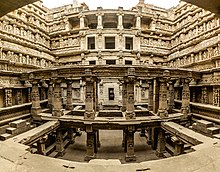 Rani ki vav is a stepwell, built by the Chaulukya dynasty, located in Patan.
Rani ki vav is a stepwell, built by the Chaulukya dynasty, located in Patan.
-
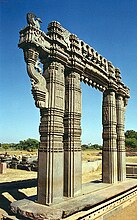 Kakatiya Kala Thoranam (Warangal Gate) built by the Kakatiya dynasty in ruins.
Kakatiya Kala Thoranam (Warangal Gate) built by the Kakatiya dynasty in ruins.
-
 Chennakesava Temple is a model example of the Hoysala architecture.
Chennakesava Temple is a model example of the Hoysala architecture.
-
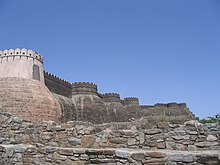 Built during the course of the 15th century by Rana Kumbha, the walls of the fort of Kumbhalgarh claimed to be the one of the longest continuous wall.
Built during the course of the 15th century by Rana Kumbha, the walls of the fort of Kumbhalgarh claimed to be the one of the longest continuous wall.
-
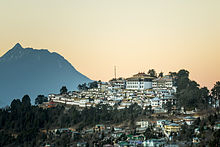 Tawang Monastery in Arunachal Pradesh, was built in the 1600s, is the largest monastery in India and second largest in the world after the Potala Palace in Lhasa, Tibet.
Tawang Monastery in Arunachal Pradesh, was built in the 1600s, is the largest monastery in India and second largest in the world after the Potala Palace in Lhasa, Tibet.
Support or Oppose
- Support: The rotating image provides value to section. (Highpeaks35 (talk) 02:34, 2 January 2019 (UTC))
New Images - Sports
- Rotate

- Images
-
 Indian hockey team, captained by Dhyan Chand (standing second from left), after winning the finals at the 1936 Summer Olympics – their third of six consecutive Olympic golds.
Indian hockey team, captained by Dhyan Chand (standing second from left), after winning the finals at the 1936 Summer Olympics – their third of six consecutive Olympic golds.
-
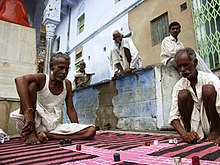 A street-corner game of pachisi in Pushkar, Rajasthan.
A street-corner game of pachisi in Pushkar, Rajasthan.
-
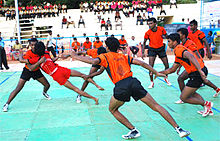 A game of kabaddi at the Asian Games.
A game of kabaddi at the Asian Games.
-
Old polo field in Imphal, Manipur. The current polo game in its modern form originated in Manipur.
-
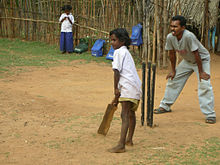 Cricket is the most popular game among India's masses. Shown here is an instance of street cricket.
Cricket is the most popular game among India's masses. Shown here is an instance of street cricket.
- Kalarippayattu, a martial art native to Kerala. Kalarippayattu, a martial art native to Kerala.
-
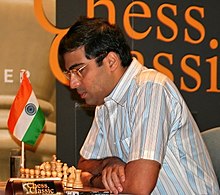 Indian chess grandmaster and former world champion Vishwanathan Anand competes at a chess tournament in 2005. Chess is commonly believed to have originated in India in the 5th century CE.
Indian chess grandmaster and former world champion Vishwanathan Anand competes at a chess tournament in 2005. Chess is commonly believed to have originated in India in the 5th century CE.
-
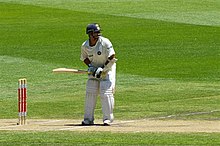 During a twenty four-year career, Sachin Tendulkar has set many batting records, including most runs in both tests and ODIs and most number of centuries in both tests and ODIs, making him one of the most successful cricketers ever.
During a twenty four-year career, Sachin Tendulkar has set many batting records, including most runs in both tests and ODIs and most number of centuries in both tests and ODIs, making him one of the most successful cricketers ever.
Support or Oppose
- Support: The rotating image provides value to section. (Highpeaks35 (talk) 02:34, 2 January 2019 (UTC))
New Images - Motion pictures, television
- Rotate

- Images
-
 Advertisement in The Times of India of 25 May 1912 announcing the screening of the first feature film of India, Shree Pundalik by Dadasaheb Torne.
Advertisement in The Times of India of 25 May 1912 announcing the screening of the first feature film of India, Shree Pundalik by Dadasaheb Torne.
-
 A scene from Raja Harishchandra (1913), the first full-length Indian motion picture.
A scene from Raja Harishchandra (1913), the first full-length Indian motion picture.
-
 Producer-director-screenwriter Dadasaheb Phalke, the "father of Indian cinema".
Producer-director-screenwriter Dadasaheb Phalke, the "father of Indian cinema".
-
 AVM Studios in Chennai, India's oldest surviving film studio.
AVM Studios in Chennai, India's oldest surviving film studio.
References
- ^ Banerjee, Mukulika & Miller, Daniel (2003) The Sari. Oxford; New York: Berg ISBN 1-85973-732-3
- Rosen, Elizabeth S. (1975). "Prince ILango Adigal, Shilappadikaram (The anklet Bracelet), translated by Alain Damelou. Review". Artibus Asiae. 37 (1/2): 148–150. doi:10.2307/3250226. JSTOR 3250226.
- Rosen, Elizabeth S. (1975). "Prince ILango Adigal, Shilappadikaram (The anklet Bracelet), translated by Alain Damelou. Review". Artibus Asiae. 37 (1/2): 148–150. doi:10.2307/3250226. JSTOR 3250226.
- ^ Didactic Narration: Jataka Iconography in Dunhuang with a Catalogue of Jataka Representations in China, Alexander Peter Bell, LIT Verlag Münster, 2000 p.15ff
Support or Oppose
- Support: The rotating image provides value to section. (Highpeaks35 (talk) 02:34, 2 January 2019 (UTC))
Comments
- Any reason why we need more images the article appears to have enough already. MilborneOne (talk) 00:28, 2 January 2019 (UTC)
- These are rotating images for each section. These sections above are blank without any images and having one rotating image provide the reader with an added value. I am not proposing we have several images per section, just one rotating image which adds value - as mentioned, just the noted sections above which do not have any image. (Highpeaks35 (talk) 00:36, 2 January 2019 (UTC))
- OK but I object to the new images, I dont think we need any more and commons is available to those interested. Some of the section are just overviews that already have image filled articles linked. MilborneOne (talk) 00:40, 2 January 2019 (UTC)
- @MilborneOne: Understood, but, let me know if you find any of the above rotating galleries useful to their respected section. Or you object to all of it? (Highpeaks35 (talk) 00:43, 2 January 2019 (UTC))
- I personally think we should have something for sports and clothing, at least. But, that is just me. We obviously need to agree as a community. :) (Highpeaks35 (talk) 00:45, 2 January 2019 (UTC))
- OK but I object to the new images, I dont think we need any more and commons is available to those interested. Some of the section are just overviews that already have image filled articles linked. MilborneOne (talk) 00:40, 2 January 2019 (UTC)
- These are rotating images for each section. These sections above are blank without any images and having one rotating image provide the reader with an added value. I am not proposing we have several images per section, just one rotating image which adds value - as mentioned, just the noted sections above which do not have any image. (Highpeaks35 (talk) 00:36, 2 January 2019 (UTC))
Agree with @MilborneOne: We don't need new images, especially not adolescent touristy ones. India is not an industrialized power, at least the industrialization has not brought uniform wealth; otherwise India's rank in the list of countries by per capita income wouldn't still be 140 out of 180, just a few ranks above Pakistan and well below Sri Lanka and Bhutan. India is still a largely rural country. The percentage of Indians living in rural areas per the last census was 69%, some 3% below the previous census, but still more than two thirds. None of the images I see upstairs are of any worth for an FA. Recall, for those who remember, there was a time when only Featured Pictures were fielded in India, Misplaced Pages's oldest country featured article. We can't let it go to dogs on somebody's whim or fantasy. Fowler&fowler«Talk» 01:49, 2 January 2019 (UTC)
- We certainly can't have pictures of a bunch of so-called Rajputs dressed up at a wedding, with caption: "Achkan sherwani and churidar (lower body) worn by Maharaja Arvind Singh Mewar and his kin during a Hindu wedding in Rajasthan, India." What Maharaja? The privileges, titles, and remuneration to the former rulers of princely states were abolished in 1971. And this fellow is a distant relative. He was the manager of the Lake Palace Hotel in Udaipur, where the Ambani's had Beyonce perform recently. Might as well have a picture of Beyonce in Indian outfit. Fowler&fowler«Talk» 01:59, 2 January 2019 (UTC)
- PS I mean we can't have that picture on Misplaced Pages, let alone an FA. Please someone, delete it from WP, and the Maharaja's page as well. Fowler&fowler«Talk» 02:01, 2 January 2019 (UTC)
- @Fowler&fowler: If Maharaja's sherwani picture does not meet FA, that is fine. We can remove it. That is the type of discussion we need to have, not edit warring. (Highpeaks35 (talk) 02:08, 2 January 2019 (UTC))
- But you can't load pictures or text en mass as you have been doing in a Featured Article and then expect us to clean up your mess one item at a time. Similarly, please revert the textual mess you have created in the lead and the history and (probably) other sections to the stable version of RegentsPark. Then bring them up here for discussion one at a time (not in a big data dump). Fowler&fowler«Talk» 02:16, 2 January 2019 (UTC)
- One thing at a time. It will get done. Also, what does industrialization have to do with the above? Those images are mainly about culture - not economy, per se. I think you are bringing User:King Zebu edits as well. But, those were accepted awile back by consensus. (Highpeaks35 (talk) 02:18, 2 January 2019 (UTC))
- The textual edits were certainly weren't accepted by RegentsPark as I reverted to his reversion. Sorry, I can't discuss a image dump. All your images are poor quality. Fowler&fowler«Talk» 02:27, 2 January 2019 (UTC)
- That is certainly fine. Let other editors comment. Thank you for giving your input, instead of edit warring. (Highpeaks35 (talk) 02:29, 2 January 2019 (UTC))
- The textual edits were certainly weren't accepted by RegentsPark as I reverted to his reversion. Sorry, I can't discuss a image dump. All your images are poor quality. Fowler&fowler«Talk» 02:27, 2 January 2019 (UTC)
- One thing at a time. It will get done. Also, what does industrialization have to do with the above? Those images are mainly about culture - not economy, per se. I think you are bringing User:King Zebu edits as well. But, those were accepted awile back by consensus. (Highpeaks35 (talk) 02:18, 2 January 2019 (UTC))
- But you can't load pictures or text en mass as you have been doing in a Featured Article and then expect us to clean up your mess one item at a time. Similarly, please revert the textual mess you have created in the lead and the history and (probably) other sections to the stable version of RegentsPark. Then bring them up here for discussion one at a time (not in a big data dump). Fowler&fowler«Talk» 02:16, 2 January 2019 (UTC)
- @Fowler&fowler: If Maharaja's sherwani picture does not meet FA, that is fine. We can remove it. That is the type of discussion we need to have, not edit warring. (Highpeaks35 (talk) 02:08, 2 January 2019 (UTC))
- PS I mean we can't have that picture on Misplaced Pages, let alone an FA. Please someone, delete it from WP, and the Maharaja's page as well. Fowler&fowler«Talk» 02:01, 2 January 2019 (UTC)
I'm still waiting for you to revert the text to the last stable version of RegentsPark. I don't see any consensus for the textual edits, to the poor language, exaggerated tone, etc. If you push your luck too much, I'll put it on FAR and have the FA status removed, and then you and your cohorts can work on a sinking ship all you want. Fowler&fowler«Talk» 02:35, 2 January 2019 (UTC)
- We will move as we build consensus, not by your impatience. You do what needs to be done, however, I am not responsible for all the edits for the last year. (Highpeaks35 (talk) 02:38, 2 January 2019 (UTC))
Text
Fowler&fowler (talk · contribs) Which text are you referring to? This one in the lead? Please advise:
The Indian subcontinent was home to the urban Indus Valley Civilisation of the 3rd millennium BCE — one of the world's earliest civilizations. The Iron Age Vedic period, saw the composition of the Vedas, the seminal texts of Hinduism, coalesced into Janapadas (monarchical, state-level polities), and social stratification based on caste. Large-scale urbanization occurred on the Indo-Gangetic Plain in the first millennium BCE leading to the Mahajanapadas (large, urbanised states), and Buddhism and Jainism arose. Early political consolidations took place under the Magadhan dynasties of Nandas, Mauryas and Guptas from the north and by the Satavahanas and Chalukyas in the Deccan; the later peninsular Middle Kingdoms, notably Pallavas and Cholas, influenced cultures as far as Southeast Asia; while the Tripartite Struggle, centred on Kannauj, lasted for more than two centuries for the control of the Indian subcontinent between the Palas, Rashtrakutas, and Gurjara-Pratiharas in the early Medieval era. Much of the north fell to the Delhi sultanate; the south was united under the Vijayanagara Empire. The country was unified in the 17th century by the Mughals, during this period Sikhism arose. In the 18th century, much of the Indian subcontinent came under imperial Maratha and Sikh rule, however, by the mid-19th century much of the Indian subcontinent came under the British East India Company, and in the mid-19th under British crown rule. A nationalist movement emerged in the late 19th century, which later, under Mahatma Gandhi, was noted for nonviolent resistance and led to India's independence in 1947.
(Highpeaks35 (talk) 02:45, 2 January 2019 (UTC))
- This is the last stable version of RegentsPark. It isn't a year old, but from 27 November 2018. Please revert to it. Then bring your textual edits here one at a time for discussion. Fowler&fowler«Talk» 02:48, 2 January 2019 (UTC)
- He already reverted it. Again, I am not responsible for those other edits. The above paragraph is what I worked on. Let me know what you don't like. We can work on the other ones as well. Even though, those are not mine. But, I do agree with it. So, I have no issue working with you on it. (Highpeaks35 (talk) 02:52, 2 January 2019 (UTC))
- Fowler&fowler (talk · contribs) What is objectionable on the above paragraph? (Highpeaks35 (talk) 03:14, 2 January 2019 (UTC))
- I'm sorry but the prose is too poor for an FA. There is redundancy, e.g. after mentioning 3rd millennium BCE what need is there to say "one of the world's earliest civilizations. There are claims for which there is no consensus among scholars, such as Vedas being "the seminal texts of Hinduism." The next sentence is run-on. What does "coalesced into Janapadas and social-stratification based on caste" mean? "Coalesce" means "to combine, to merge, to form one whole." It seems to be merging into two things. "Later shifting to British crown rule?" It didn't just shift; it was the result of the Rebellion of 1857, which resulted in the abolition of Company rule and direct administration by the Crown. You've removed mention of Christianity, Islam, Judaism etc. Sorry, it is a non-starter. We had hammered out the lead over months, a sentence at a time. Yours is too bloated, even after removal of some previous text, it has added four lines. This was the stable version:
- Fowler&fowler (talk · contribs) What is objectionable on the above paragraph? (Highpeaks35 (talk) 03:14, 2 January 2019 (UTC))
- He already reverted it. Again, I am not responsible for those other edits. The above paragraph is what I worked on. Let me know what you don't like. We can work on the other ones as well. Even though, those are not mine. But, I do agree with it. So, I have no issue working with you on it. (Highpeaks35 (talk) 02:52, 2 January 2019 (UTC))
- This is the last stable version of RegentsPark. It isn't a year old, but from 27 November 2018. Please revert to it. Then bring your textual edits here one at a time for discussion. Fowler&fowler«Talk» 02:48, 2 January 2019 (UTC)
The Indian subcontinent was home to the urban Indus Valley Civilisation of the 3rd millennium BCE. In the following millennium, the oldest scriptures associated with Hinduism began to be composed. Social stratification, based on caste, emerged in the first millennium BCE, and Buddhism and Jainism arose. Early political consolidations took place under the Maurya and Gupta empires; the later peninsular Middle Kingdoms influenced cultures as far as Southeast Asia. In the medieval era, Judaism, Zoroastrianism, Christianity, and Islam arrived, and Sikhism emerged, all adding to the region's diverse culture. Much of the north fell to the Delhi Sultanate; the south was united under the Vijayanagara Empire. The economy expanded in the 17th century in the Mughal Empire. In the mid-18th century, the subcontinent came under British East India Company rule, and in the mid-19th under British crown rule. A nationalist movement emerged in the late 19th century, which later, under Mahatma Gandhi, was noted for nonviolent resistance and led to India's independence in 1947. Fowler&fowler«Talk» 03:31, 2 January 2019 (UTC)
- This version is missing a lot of info. But, I can agree with many of your points and disagree.
- "one of the world's earliest civilizations - we can remove that.
- "the seminal texts of Hinduism" - we can remove that.
- Both Kuru and Panchala did "coalesce", they were tribes that formed a realm. The name Panchala itself is a coalesce of 5 tribes. However, I don't want to make it like the Greek-Macedonia name dispute, and fight you over that word. How about emerge? Or any other word you recommend for the Janapadas.
- "You've removed mention of Christianity, Islam, Judaism etc." - Christianity and Judaism played a small role compared to Hinduism or Islam. And Islam was mentioned with Delhi Sultanate and Mughals.
- Please note: Misplaced Pages:There is no deadline
- Fowler&fowler (talk · contribs) As such, is this acceptable. I took all your concerns and addressed it. Kindly let me know what else needs to be changed, if there is any:
The Indian subcontinent was home to the urban Indus Valley Civilisation of the 3rd millennium BCE. The Iron Age Vedic period, saw the composition of the Vedas, the rise of Janapadas (monarchical, state-level polities), and social stratification based on caste. Large-scale urbanization occurred on the Indo-Gangetic Plain in the first millennium BCE leading to the Mahajanapadas (large, urbanised states), and Buddhism and Jainism arose. Early political consolidations took place under the Magadhan dynasties of Nandas, Mauryas and Guptas from the north and by the Satavahanas and Chalukyas in the Deccan; the later peninsular Middle Kingdoms, notably Pallavas and Cholas, influenced cultures as far as Southeast Asia; while the Tripartite Struggle, centred on Kannauj, lasted for more than two centuries between the Palas, Rashtrakutas, and Gurjara-Pratiharas in the early Medieval era. The late Medieval period saw the growth of Muslim population, with much of the north fell to the Delhi sultanate; the south was united under the Vijayanagara Empire. In the 17th century, much of the subcontinent was unified by the Mughals, during this period Sikhism arose. In the 18th century, much of the Indian subcontinent came under imperial Maratha and Sikh rule, however, by the mid-19th century much of the Indian subcontinent came under the British East India Company, and by the mid-19th under British crown rule. A nationalist movement emerged in the late 19th century, which later, under Mahatma Gandhi, was noted for nonviolent resistance and led to India's independence in 1947.
(Highpeaks35 (talk) 03:49, 2 January 2019 (UTC))
- Sadly, the prose is not even G class much less FA. Sorry, but you can't present a paragraph. I have given you the stable version. If you want to change a sentence, please present that sentence and your improvement, and we can have that discussion. The history section of the lead of the India article is the summary style distillation of the entire history section of the India article, which in turn is the summary style distillation of all History of India articles. You are directly editing the lead. Please read WP:Lead_fixation. Again, one sentence at a time. Fowler&fowler«Talk» 04:18, 2 January 2019 (UTC)
- RegentsPark (talk · contribs) can you please mediate this? I think Fowler and I hit a wall. Can you talk into consideration both versions and make a neutral call? (Highpeaks35 (talk) 04:29, 2 January 2019 (UTC))
- Highpeaks, I haven't hit any wall. My version has been in the article for many years. This history section for some eight years. You apparently think summarizing is so easy that you can within minutes replace one doozy with another. Here is one, and there are many, in every sentence: "The late Medieval period saw the growth of Muslim population, with much of the north fell to the Delhi sultanate." Really? Who was taking the census in India before 1871? What part of the History section is that summarizing, not to mention the errors of simple syntax ? And you expect me to waste my time engaging your edits, in any rational manner. Pasted below is the actual paragraph from the history section about the Delhi sultanate and the Vijayanagara kingdom. Tell me where does that say anything about the growth of the Muslim population. It says only that the non-Muslim subjects were largely left alone; it speaks of the migration of urban elites, artists, etc from the lands devastated by the Mongols and the creation of an Indo-Islamic culture, without mentioning any demographic bump. More generally, you have bloated the text with names of Hindu rulers, exaggerating their relatively short-lived confederacies or kingdoms to empires. Really, the Marathas came to control much of the subcontinent? Did they ever reach the Sutlej? Did they ever get below the Krishna river? Ever in Awadh? Ever into Bengal, other than their periodic raids of mass murder and rape, including of the weavers of Cossimbazar and Dacca? Did they leave behind perhaps, a Qutub Minar, a Red Fort, a Humayun's Tomb, an Agra Fort, a Fatehpur Sikri, even crumbling monuments of architectural significance in the Western Ghats? In 1707, Aurengzeb was still in the Deccan, the heartland of the Marathas, when he died, and in 1761, the Marathas had been defeated in the Battle of Panipat by the Afghans, not to mention the British winning the Battle of Buxar in 1764, and controlling the revenue in Bengal, Bihar, and Orissa. So, half a century constitutes the Maratha Empire, but two centuries of Mughal rule, acknowledged around the world, with the many linguistic uses of the word "Moghul," you refer to as ]? Here is the first half of the original of what you seem to be summarizing by some mysterious artifice of historiography and precis writing: Fowler&fowler«Talk» 16:05, 2 January 2019 (UTC)
- The relevant paragraph from the history section: "After the 10th century, Muslim Central Asian nomadic clans, using swift-horse cavalry and raising vast armies united by ethnicity and religion, repeatedly overran South Asia's north-western plains, leading eventually to the establishment of the Islamic Delhi Sultanate in 1206. The sultanate was to control much of North India and to make many forays into South India. Although at first disruptive for the Indian elites, the sultanate largely left its vast non-Muslim subject population to its own laws and customs. By repeatedly repulsing Mongol raiders in the 13th century, the sultanate saved India from the devastation visited on West and Central Asia, setting the scene for centuries of migration of fleeing soldiers, learned men, mystics, traders, artists, and artisans from that region into the subcontinent, thereby creating a syncretic Indo-Islamic culture in the north. The sultanate's raiding and weakening of the regional kingdoms of South India paved the way for the indigenous Vijayanagara Empire. Embracing a strong Shaivite tradition and building upon the military technology of the sultanate, the empire came to control much of peninsular India, and was to influence South Indian society for long afterwards." Fowler&fowler«Talk» 16:05, 2 January 2019 (UTC)
Fowler&fowler (talk · contribs) by that logic, how was Christianity or Judaism significant to the history of the subcontinent? I don’t think British considered themselves as Christian power, as they divided Indian history in Hindu, Muslim and British. Why put Judaism here? Isn’t that exaggerating Jewish history in India? If you are impartial, shouldn’t Christianity and Judaism which take a sentence be removed? We can add Sikhs in the same sentence after Mughals. (2600:1001:B100:6459:CD2E:5ED4:363D:6690 (talk) 17:19, 2 January 2019 (UTC))
- ^ Singh, Upinder (2008). A History of Ancient and Early medieval India : from the Stone Age to the 12th century. New Delhi: Pearson Education. p. 137. ISBN 9788131711200.
- Misplaced Pages articles that use Indian English
- Misplaced Pages featured articles
- Featured articles that have appeared on the main page
- Featured articles that have appeared on the main page once
- All unassessed articles
- FA-Class India articles
- Top-importance India articles
- FA-Class India articles of Top-importance
- India portal selected articles
- WikiProject India articles
- FA-Class South Asia articles
- Top-importance South Asia articles
- South Asia articles
- FA-Class Asia articles
- Top-importance Asia articles
- WikiProject Asia articles
- WikiProject templates with unknown parameters
- FA-Class country articles
- WikiProject Countries articles
- Misplaced Pages pages referenced by the press







